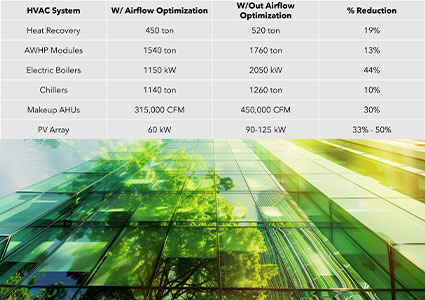Net-zero buildings require a shift to an efficiency first mindset
The global push to meet aggressive decarbonization goals and achieve net-zero emissions by 2050 is intensifying, and commercial buildings are at the forefront of this movement. As the built environment accounts for a substantial portion of global carbon emissions, there is a growing recognition that energy efficiency is the cornerstone of any effective decarbonization strategy. While advanced technologies like renewable energy, hydrogen, and carbon capture grab the spotlight, energy efficiency remains mostly as an unsung hero – a low-hanging fruit that not only reduces emissions but also slashes operational costs, paving the way for deeper decarbonization.

The ‘efficiency first’ imperative
In recent years, there has been a growing consensus among commercial building owners, engineers, and sustainability leaders that an ‘efficiency first’ mindset is the necessary starting point for decarbonization. This approach prioritizes energy efficiency measures before deploying other decarbonization strategies like renewable energy and building electrification.
When addressing critical spaces such as a lab or cleanroom, optimizing airflow first provides significant savings on future projects by reducing the building’s baseload energy requirement while delivering a quick return on investment (ROI). Unlike renewable energy installations, which require significant upfront capital, or emerging technologies like hydrogen fuel, which are still evolving, energy efficiency projects like airflow optimization can provide rapid paybacks that help finance other decarbonization efforts. In fact, in some cases airflow efficiency as an efficiency first method can deliver five dollars in follow-up electrification costs for every one dollar spent.
Energy efficiency: real-world applications
The most recognizable form of energy efficiency – lighting – has already seen widespread adoption, with LED upgrades becoming the norm. However, the next frontier for efficiency is optimizing airflow which offers one of the most impactful opportunities to reduce energy demand. This is because most spaces are over ventilated and some of the most energy intensive buildings, like labs, bring in 100 percent outside air at higher air change rates per hour than necessary based on current IAQ in the space.
The ‘efficiency first’ strategy targets both energy demand and future electrification needs, allowing for significant carbon reductions while delivering attractive financial returns. Many life sciences companies and universities, which operate energy-intensive labs and cleanrooms, are already adopting this approach, saving money while reducing their carbon footprints. That is because expensive electrical infrastructure and equipment (like heat pumps, electric boilers or onsite solar) can be downsized. Appropriately sizing this equipment and intelligently controlling ventilation rates will also reduce operating and maintenance costs year after year, including reducing the amount of expensive clean electricity that must be purchased.
The below example shows the impact that an efficiency first approach using airflow optimization can have on equipment sizing for a lab building.
 In many cases, improving HVAC efficiency not only slashes energy consumption but also enhances productivity and well-being by creating healthier indoor environments. For example, better air quality and optimized temperature control can increase employee productivity and improve safety in laboratory and industrial settings. Airflow optimization can also enhance safety protocols by capturing air quality data, empowering environmental health & safety (EH&S) teams.
In many cases, improving HVAC efficiency not only slashes energy consumption but also enhances productivity and well-being by creating healthier indoor environments. For example, better air quality and optimized temperature control can increase employee productivity and improve safety in laboratory and industrial settings. Airflow optimization can also enhance safety protocols by capturing air quality data, empowering environmental health & safety (EH&S) teams.
Looking forward: scaling the energy transition
The journey to Net Zero is challenging, but implementing energy efficiency first offers immediate carbon reduction and as the most accessible strategy, it reduces the size of the hill we must climb to decarbonize the built environment. By adopting an ‘efficiency first’ mindset, we can not only reduce carbon emissions but also make the energy transition smoother, faster, and more affordable. To achieve our 2050 goal, the time to act is now, and the solution is clear: efficiency is the first and most critical step on the path to Net Zero.
For a list of the sources used in this article, please contact the editor.
By Dan Diehl
www.aircuity.com
Dan Diehl is CEO of Aircuity, Inc. Aircuity has been the leader in reducing energy and carbon emissions while creating healthier indoor environments for over 20 years. Commercial, institutional and lab building owners can protect occupants, improve employee productivity and wellness, lower operating costs, and verifiably reduce energy use by as much as 60 percent. Headquartered in Norwood, MA, Aircuity’s solutions have benefited organizations such as Google, SUNY, Eli Lilly, Takeda, the University of Pennsylvania, and the University of California-Irvine.
